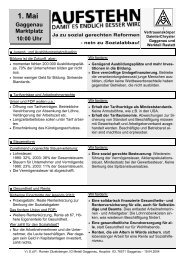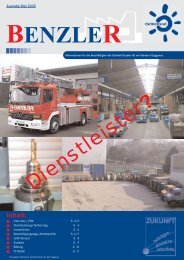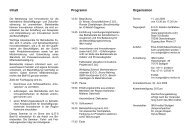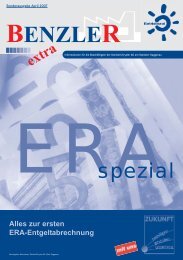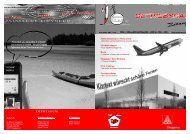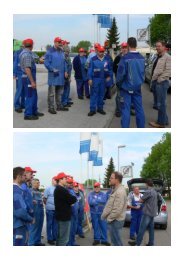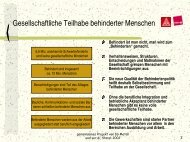Benzler Dezember 2004 - IG Metall Gaggenau
Benzler Dezember 2004 - IG Metall Gaggenau
Benzler Dezember 2004 - IG Metall Gaggenau
- Keine Tags gefunden...
Erfolgreiche ePaper selbst erstellen
Machen Sie aus Ihren PDF Publikationen ein blätterbares Flipbook mit unserer einzigartigen Google optimierten e-Paper Software.
the relatively more productive firms are able to self-select into exporting and overcomethe associated fixed costs. A reduction in trade costs will lower the export threshold 1 fornew firm entrants. If the cut-off to become an exporter decreases then the number ofexporters (probability of exporting) increases since more firms are now competitive in theforeign market. 2 Roberts and Tybout (1997) documented the importance of sunk costsof exporting. They found that previous entry has significant predicting power for futureparticipation indicating that there are sunk/fixed costs associated with exporting. 3Following a decrease in trade costs all MPE models predict an increase in firm aggregatetrade flow (X), but differ in terms of dynamics and mechanisms within the firm, at theproduct level. The model by Bernard, Redding, and Schott (2011) incorporates two typesof fixed costs: a country specific fixed cost (e.g. to build distribution networks); and aproduct-specific fixed cost (e.g. due to regulatory standards or product adjustments).A drop in trade costs would induce firms to produce fewer varieties and increase exportvolume of products already being exported. Additionally, lower trade costs will makeit profitable to export more varieties. 4The model by Eckel and Neary (2010) showshow increased competition may induce firms to focus on products close to their corecompetency. Mayer, Melitz, and Ottaviano (2014) incorporate competition effects inthe destination market and show how increased competition drives firms to skew theirexport sales to their better performing products and alter their product mix. In bothEckel and Neary (2010) and Mayer, Melitz, and Ottaviano (2014), trade liberalizationwould allow firms to export products further away from their core competency. Arkolakis,1 "Productivity cut-off" or sunk cost of exporting.2 Increased competition may also cause the least productive firms to exit (shut-down).3 Using a similar estimation strategy, corresponding results are found by Bernard and Jensen (<strong>2004</strong>)for US manufacturing firms and Gullstrand (2011) for the Swedish food sector. Other studies have lookedat how sunk export costs may be destination specific. Moxnes (2010) finds that while some costs ofexporting are common for all countries (global) the country-specific costs are estimated to be up to threetimes higher. Gullstrand and Persson (2014) find that firms tend to stay longer in core compared toperipheral markets, indicating differing sunk costs based on the destination market.4 The model contains an analogous selection mechanism, as described above at the firm level, butnow at the product level. There is a within-firm selection effect of firms dropping their "worst" productsin production (lowest attributes) and shifting resources towards their "better" products that they arenow able to export. Hence, it has become profitable to export a larger range of products due to a lower"product cut-off".4



